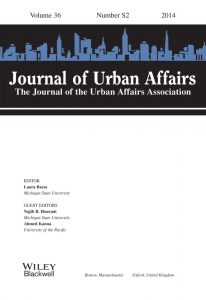Exploring Homelessness: Causation and Measures of Eradication
The issue of homelessness is a sociological inquiry that has been relatively understudied, albeit the phenomenon’s unremitting development. According to Meanwell (2012), in the United States homelessness has continued to grow since the early 1980s with a particular proliferation among vagrant women and families. In 1984, the cities of New York, Chicago, and Los Angeles had the largest number of homeless persons per population, with New York witnessing the highest rates of homeless individuals (Wolch, Dear, & Akita, 1988). The concept of homelessness is not an easily defined term. While the average person understands the basic concept of vagrancy, researchers in the sociological field have applied inconsistent definitions to the concept of homelessness, understandably so as the notion encompasses a dimension more exhaustive than a singular definition of “an individual without residence.” Homelessness comprises a continuum ranging from the absence of a permanent shelter to poor living arrangements and housing conditions. According to Wolch et al. (1988), homelessness is not an abrupt experience, rather it is “the culmination of a long process of economic hardship, isolation, and social dislocation” that has affected an individual or family ( p.443). Additionally, states of vagrancy may come in varying forms, such as street residence, temporary habitation in shelters, or assistance from service organizations, such as soup kitchens and the Salvation Army.
The experience of the destitute is understandably a harsh reality as many homeless persons have to contend with abysmal living conditions, pitiable hygiene, unsanitary food, and inadequate nutrition (Meanwell, 2012). The deprivation of basic amenities afforded to the normal population engenders grander potential for malnutrition, poor mental health and a range of other physiological and psychological illnesses. Though men on average experience chronic homelessness than any other group, recent trends in the homeless population have expanded the demographic profile of the homeless to include women, children, families, substance abusers, the unemployed, and mentally-disabled (Wolch et al., 1988). Nonetheless, despite the recent diversity (age, race, gender, and ethnicity) in the vagrant population, homelessness largely remains a gendered experience, in the sense that, overall men are more likely to experience chronic homelessness than females and homeless women are typically single parents accompanied by children (Meanwell, 2012; Wolch, Dear, & Akita, 1988). Moreover, certain social services provided to the homeless are contingent on gendered social expectations. For example, women are more likely to have access to shelters than men as females are considered to be at a higher risk of violent victimization and sexual abuse. Additionally, women are also more likely to be involved in sex crimes as a means of survival, such as the commercial exchange of sex for food and shelter (Meanwell, 2012).
One can surmise that lack of affordable housing is a basic cause of homelessness. However, in conjunction with this source of vagrancy, other conditions in the United States have precipitated homelessness, including deindustrialization, deinstitutionalization, and welfare state reorganization. According to Wolch et al. (1988), these events played a chief role in the development of vagrancy. The authors elucidated that the economic consequences of deindustrialization impacted homelessness due to the decline in the manufacturing sectors, especially in the snowbelt cities of the North-east. The process of deindustrialization was compounded with economic recessions and fluctuations in the U.S. currency that resulted in job losses and weakening of union membership. According to the authors, “these factors raised unemployment levels and created the highest rate of official poverty since the early 1960s. [And], by 1982, 15 percent (34.4 million) of the nation’s population was living below the poverty line” (Wolch et al., 1988, p.446).
Deinstitutionalization of the mentally-ill in the United States created the release of a large group of mentally-disabled individuals who lacked residence upon discharge from mental institutions. Being that the government’s provisions of community-based programs and community-based shelters were inadequate to meet the demand of this special population, many released persons ended up on the periphery of poverty—seeking shelters in the most deprived neighborhoods and on the streets. Additionally, the decrease in federal expenditure on welfare budgets during the 1980s, specifically under the Reagan administration, caused many persons who were previously dependent on welfare and social services to seep deeper into poverty (Wolch et al., 1988).
Interestingly, public views on homelessness tend to be benign and commiserating in nature, but ironically, some individuals who are sympathetic about the issue would not support unstinting policies or social service programs for this population. The unfavorable responses for allocation of resources towards this population may stem from the prejudicial view of these persons as lazy. Additionally, citizens may deem homeless persons culpable for their fiscal failure that led to their residence on the street. These stigmas may not be derived solely from being homeless but may be a result of a combination of other stereotypes, such as prior criminal history, drug dependence, and racial stereotypes, particularly if the homeless person is black. The homeless are aware that persons stigmatize them and in order to relinquish that identity; some persons would dissociate themselves from other homeless persons and social service agencies that would serve to help them— which marks a preservation of self-pride (Meanwell, 2012). However, this mechanism of self-salvage engenders more harm than good as alienation from social service resources only exacerbate the struggles of the street.
I have had many personal experiences with the homeless population as I reside not too far from a domicile where many homeless persons tend to stay, which is ironically in a middle class suburban residence. I have had conversations with homeless persons and most of these conversations ended in me querying their reason for becoming homeless. The responses from the majority of persons are that they have lost their job, got divorced, or have just financially encountered hard times. Despite the diverse rationale, the consensus is tied to a single economic variable, “money”. Homeless persons are on the street because they cannot afford housing, are most times dearth of family members’ monetary assistance, and are not receiving or are not eligible to receive certain government benefits. The economic burden makes it insurmountable for them to have any other avenue but to resort to tenancy on the street. To compound matters, some of these homeless persons have meager qualifications or educational attainments, making it even more challenging to obtain employment. Therefore, the streets or shelters remain their only place of refuge.
The phenomenon of homelessness is, I believe, a product of societal stratification and social inequalities. Ideologies of social stratification and its effect on poverty were originally proposed by Karl Marx (2004) who contended that the capitalist society produces two prominent classes that are in conflict with each other: Bourgeoisie and Proletariats. The bourgeoisie are the oppressors who own the means of production and the proletariats are the oppressed workers who labor for the bourgeoisie. The author suggests that capitalism produces social inequalities, but the state never sees social imperfections as a consequence of the state, but rather as a consequence of natural law, private life, and inadequacies of the administration. The author explains that capitalism is distinguished not by privilege but instead by individuality of property ownership and that those who create the conditions of the oppressed group express this power in the form of laws that function to serve the bourgeoisie’s interests (Marx, 2004, p.129). Hence, based on the earlier writing of Marx, capitalism is responsible for the manifestation of certain social conditions that have led to homelessness. The structural stratification of society enables the development of inequality in the labor market and other areas of social life, which forces persons to be confined to certain marginal economic statuses; due to the frailty of these economic conditions poverty becomes an inevitable consequence.
The literature suggests that vagrancy is not a problem easily combated as the structural inadequacies that birth and perpetuate its development cannot be easily changed. To advocate for an entire restructuring of society may be ideologically appropriate but far-fetched from practicality. Therefore, a comprehensive understanding of homelessness is essential in order to address this phenomenon. It is clear that more generous welfare policies are needed in order to provide individuals with assistance; increased federal expenditure on housing is required along with job and skills training for individuals currently homeless. Additionally, the creation and expansion of social service agencies that offers residence to the homeless is necessary. However, it is indispensable that these agencies cater to specific categories of homeless persons (i.e. substance abusers, mentally-ill, unemployed) instead of housing multiple types of homeless individuals together as each person has special needs and requirements. It is only through more ardent liberal approaches that we will eventually work to eradicate vagrancy.
References
Marx, K. (2004). Class conflict and law. In J. Jacoby (Ed.), Classics of criminology
(pp.124-130). Illinois: Waveland Press, Inc.
Meanwell, E. (2012). Experiencing homelessness: A review of recent literature.
Sociology Compass, 6 (1), 72-85.
Wolch, J.R., Dear, M., & Akita, A. (1988). Explaining homelessness. Journal of the
American Planning Association, 54 (4), 443-453.





1099-0860/asset/NCB_logo.gif?v=1&s=40edfd0d901b2daf894ae7a3b2371eabd628edef)
1756-2589/asset/NCFR_RGB_small_file.jpg?v=1&s=0570a4c814cd63cfaec3c1e57a93f3eed5886c15)
I’ve been homeless. It is a humbling experience. I have a University education and worked at this same university for a number of years until I became ill for many years with Bi-polar disorder. You say you’ve talked to homeless people and that’s fine, but try being one. It gives you a whole new outlook.
It is my opinion that capitalism does create an “underclass” which is stigmatized, marginalized, and deemed to be the “fault” of the homeless person. This is particularly shown by my own experience where people told me to “just find somewhere to live.” As I come from a middle class back-round no empathy let alone help was forthcoming from friends or family. My welfare benefits allow me $270 per month for lodging. You can’t rent a storage space let alone find a decent place to live. So essentially the state is unable and unwilling to fully take care of it’s most needy citizens due to capitalist ideology.(e.g. protestant work ethic).
By Alexandra Ring
Homelessness is caused when someone lost their home or doesn’t have any money to get a home. The independent variable are the people and the dependent variable is money or a job. You need to rely on having a job to get money to have a place to live. People will always be around that won’t change. The sociological perspective is that people who have jobs and money for a home and food don’t realize that how many are consistently hungry and homeless. In bigger cities, people who see anyone homeless can and should help, they are probably use to the sight, whereas in a smaller town (like mine), it’s harder to understand or know how many are homeless, I rarely see it; if I did I would give some money to help.
Homelessness occurs because someone may have lost their home in a natural disaster such as a hurricane or tornado, they could have lost their job and been without a job for a long time and ran out of money, being born into a extremely poor family or in a poor town, and this is a little awkward but someone can be homeless if they got kicked out of a home and doesn’t know anyone to help or take them in. And last not paying your bills can cause the government to take your house and property away.
I think these are the most common because it’s what can happen in real world situations, it’s proof and a law if you don’t pay your bills the government will come and take it away. Also natural disasters happen around the world that leaves many hungry and homeless.
Thank you for reading and I hope you learned from my own post.